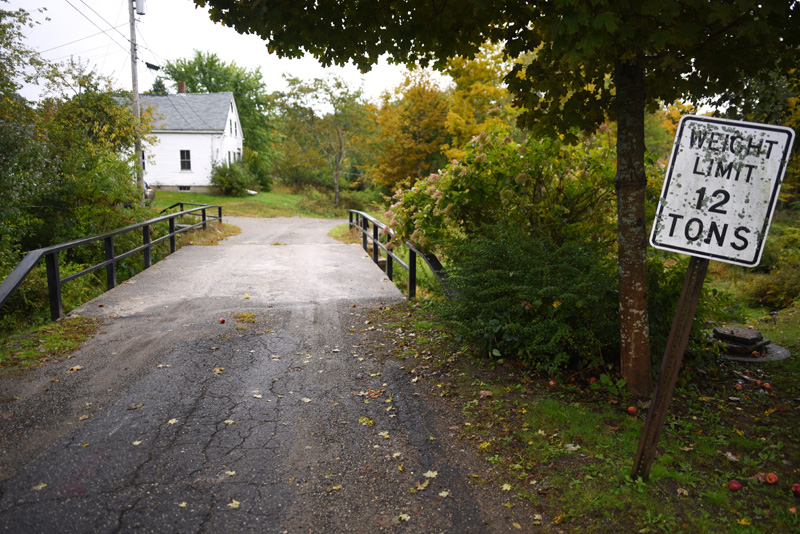
The Varney Bridge in Bristol Mills. The bridge will undergo work later this fall or next summer, according to Town Administrator Chris Hall. (Jessica Picard photo)
The Bristol Board of Selectmen terminated a contract with N.F. Luce Inc. for work on Varney Bridge, which carries Redonnett Mill Road over the Pemaquid River, at the request of the contractor Sept. 19.
N.F. Luce Inc. requested the termination due to an illness in the family-run business that has made it difficult to complete the project on time, according to Bristol Town Administrator Chris Hall.
Brian Luce, of N.F. Luce Inc., met with the selectmen, along with Eric Calderwood and Marshall Cole, of Calderwood Engineering, and Seth Hagar and Vaughn Stevens, of Hagar Enterprises Inc.
“We just can’t do it,” Luce said of the work. “I want to do it my best, I want to do the best by the town, and I can say that we just can’t.”
The contract was for a new deck and guardrails, as well as other repairs. The work will reinforce the bridge to allow safe passage of emergency vehicles, as well as construction equipment during work on the Bristol Mills Dam and fish ladder, according to Hall.
N.F. Luce submitted the low bid, $137,000, and the selectmen awarded the contract March 14, with an additional $5,600 to cover guardrails of a higher standard than the minimum galvanized-steel design.
The town had paid N.F. Luce $35,630 as of the Sept. 19 meeting. Luce requested that the contractor be able to keep $22,759.53 for work already completed, and said he would refund the town the remaining $12,870.77.
“This has never happened before, but I’m at your mercy,” he said.
“I don’t want to see any harm come to anybody because of this,” said Chad Hanna, chair of the board of selectmen. The board decided not to call in the bond posted for the work.
The selectmen agreed to terminate the contract and requested that Hagar Enterprises submit an estimate for the completion of the project, since it had submitted the second-lowest bid at $168,000.
N.F. Luce will deliver completed components, such as the deck beams and guardrails, to Hagar.
Calderwood Engineering will pursue an extension of the permit for in-stream work through the end of November, since Hagar will not be able to assign crews to the job until November, according to Hall.
If the town cannot secure an extension, the work will be scheduled for July 2019. If necessary, the town will plan to use the bridge above the dam for access to the fish ladder, if granted permission from a property owner to use the part of the land not owned by the town, according to Hall.
Route 130 paving
The Maine Department of Transportation will request bids for paving 8.5 miles of Route 130 next year, from Hanley’s Market to The Harbor Room restaurant, according to Hall.
“It’s only maintenance paving, but hopefully it’s good for five years or more,” Hall said.
Hall said he is grateful to the Lincoln County Regional Planning Commission for working with the DOT on behalf of the town.
Upper Round Pond Road bridge
Calderwood Engineering discussed estimates for replacing a small bridge next to the town hall that carries Upper Round Pond Road over the Pemaquid River.
Calderwood estimated the cost of a steel arch design at $390,000 and a concrete arch at $480,000. Both estimates incorporate funds for masonry facing, according to Hall.
Calderwood recommended the steel arch, but said it would require a longer road closure than a concrete arch.
The project will be considered for the 2019 highway budget, according to Hall.
Arch Bridge
Cole said he had spoken to the Maine Historic Preservation Commission about the town’s plans to strengthen and possibly widen the Arch Bridge, which carries Benner Road over the Pemaquid River in Bristol Mills. The bridge, built in the early 19th century, is on the National Register of Historic Places.
The bridge, which has no mortar, needs strengthening in order to continue to hold modern-day traffic. At their Aug. 15 meeting, the selectmen discussed whether to strengthen the existing bridge or build a new, modern bridge alongside it. At the meeting, the selectmen were in favor of blending the work within the historic bridge.
However, the Maine Historic Preservation Commission wants any new work to contrast with the old stonework, according to Hall.
The town will need a Maine Department of Environmental Protection permit if in-stream work is needed to replace any stonework, and the commission could refuse approval of a permit, according to Hall.
The commission “appears to take the view that any new work must be designed so as not to blend into the old, but to show a stark contrast – regardless of aesthetics,” Hall wrote in the selectmen’s meeting minutes.
Cole showed the selectmen a drawing of how a new deck would look built over the stone arch, complying with the commission’s wishes for a clear visual contrast between the new deck and the historic stonework.
Hall said the selectmen would rather not widen the bridge, in order to avoid the need for a permit and maintain the bridge’s appearance.
The town hopes to see new drawings from Calderwood Engineering by Oct. 17, according to Hall.
The town likely will not budget for the project until at least 2021, according to Hall.
Solar array
The solar array at the transfer station will likely be turned on in mid-October, after paperwork with Central Maine Power Co. approving the nine accounts to receive solar electricity is complete, according to Hall.
Other business
The selectmen reappointed William H. Brewer, CPA, as auditor for the 2018 audit. Brewer has done the service for the town since 1974, according to Hall.
Hall said the Federal Emergency Management Agency has totaled the amount of reimbursement to the town for the October 2017 storm at $9,383.84. FEMA has not disbursed the funds yet, according to Hall.



